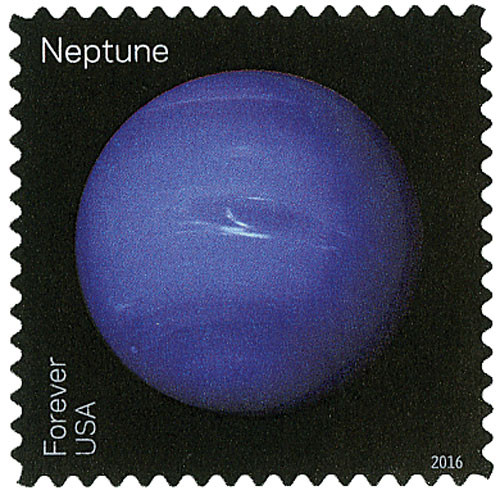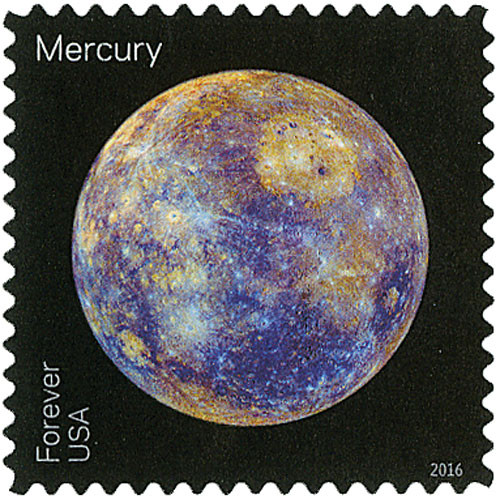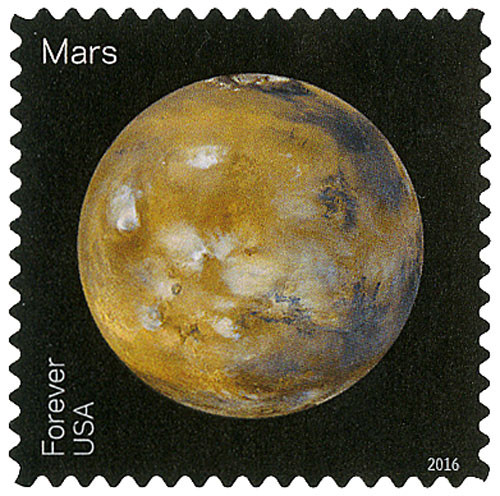
# 5076 - 2016 First-Class Forever Stamp - Views of Our Planets: Neptune
US #5076
2016 Neptune – Views of Our Planets
- Pictures Neptune, the eighth planet from the Sun
- One of 8 stamps issued alongside the 2016 Pluto Explored stamps to commemorate space exploration in our Solar System and New Horizon spacecraft’s flyby of Pluton in 2015
Stamp Category: Commemorative
Set: Views of Our Planets
Value: 47¢ First Class Mail Rate (Forever)
First Day of Issue: May 31, 2016
First Day City: New York, New York
Quantity Issued: 40,000,000
Printed by: Ashton Potter (USA) Ltd.
Printing Method: Offset
Format: Panes of 16
Tagging: Nonphosphored type III, spot tag
Why the stamp was issued: To showcase Neptune, the eighth planet from the Sun, and the NASA efforts that have allowed us to see this planet up-close. To honor NASA’s space exploration efforts within our Solar System that have given us up-close images of every plant and – as of 2015 – dwarf planet Pluto.
About the stamp designs: Pictures an image of Neptune from NASA’s Jet Propulsion Laboratory at Caltech.
First Day City: The First Day of Issue Ceremony was held at the Javits Center in New York City during the World Stamp Show 2016.
About the Views of Our Planets set: Eight stamps issued to honor NASA’s space exploration efforts within our Solar System that have given us up-close images of every planet and – as of 2015 – dwarf planet Pluto. Each stamp pictures one planet in our Solar System. According to the USPS, “Some show the planet’s ‘true’ color – what we might see with our own eyes if traveling through space. Others use colors to represent and visualize certain features of a planet based on imaging data. Still others use the near-infrared spectrum to show things that cannot be seen by the human eye in visible light.”
History the stamp represents: Because of its brilliant blue color, Neptune was named after the Roman god of the sea. The color is from the methane gas in its atmosphere.
Galileo Galilei first observed Neptune in the 1600s, but believed it was only a fixed star. Astronomers later used mathematical predictions to locate and identify Neptune as a planet in 1846.
Neptune is an “ice giant,” with an atmosphere made of hydrogen and helium, as well as ice, ammonia, and methane. Below that lies a layer of ice over a solid core the size of the Earth. Scientists believe Neptune may be the windiest planet in the solar system, with gusts blowing through clouds at more than 1,200 miles per hour. Giant storms larger than Earth, known as Dark Spots, spin across the planet for years at a time.
In 1989, the Voyager 2 probe became the first and only spacecraft to approach Neptune. It revealed a strong magnetic field and significant rotational tilt similar to Uranus. Over time, scientists found Neptune has six rings and at least 13 moons. Neptune’s largest moon, Triton, can get colder than the dwarf planet Pluto. And nitrogen gas geysers have also been spotted.
While there are no plans to visit the planet, scientists hope to send orbiters to explore Neptune and Triton in the 2020s or 2030s. Until then, we depend on ground and space telescopes to explore Neptune’s mysteries.
US #5076
2016 Neptune – Views of Our Planets
- Pictures Neptune, the eighth planet from the Sun
- One of 8 stamps issued alongside the 2016 Pluto Explored stamps to commemorate space exploration in our Solar System and New Horizon spacecraft’s flyby of Pluton in 2015
Stamp Category: Commemorative
Set: Views of Our Planets
Value: 47¢ First Class Mail Rate (Forever)
First Day of Issue: May 31, 2016
First Day City: New York, New York
Quantity Issued: 40,000,000
Printed by: Ashton Potter (USA) Ltd.
Printing Method: Offset
Format: Panes of 16
Tagging: Nonphosphored type III, spot tag
Why the stamp was issued: To showcase Neptune, the eighth planet from the Sun, and the NASA efforts that have allowed us to see this planet up-close. To honor NASA’s space exploration efforts within our Solar System that have given us up-close images of every plant and – as of 2015 – dwarf planet Pluto.
About the stamp designs: Pictures an image of Neptune from NASA’s Jet Propulsion Laboratory at Caltech.
First Day City: The First Day of Issue Ceremony was held at the Javits Center in New York City during the World Stamp Show 2016.
About the Views of Our Planets set: Eight stamps issued to honor NASA’s space exploration efforts within our Solar System that have given us up-close images of every planet and – as of 2015 – dwarf planet Pluto. Each stamp pictures one planet in our Solar System. According to the USPS, “Some show the planet’s ‘true’ color – what we might see with our own eyes if traveling through space. Others use colors to represent and visualize certain features of a planet based on imaging data. Still others use the near-infrared spectrum to show things that cannot be seen by the human eye in visible light.”
History the stamp represents: Because of its brilliant blue color, Neptune was named after the Roman god of the sea. The color is from the methane gas in its atmosphere.
Galileo Galilei first observed Neptune in the 1600s, but believed it was only a fixed star. Astronomers later used mathematical predictions to locate and identify Neptune as a planet in 1846.
Neptune is an “ice giant,” with an atmosphere made of hydrogen and helium, as well as ice, ammonia, and methane. Below that lies a layer of ice over a solid core the size of the Earth. Scientists believe Neptune may be the windiest planet in the solar system, with gusts blowing through clouds at more than 1,200 miles per hour. Giant storms larger than Earth, known as Dark Spots, spin across the planet for years at a time.
In 1989, the Voyager 2 probe became the first and only spacecraft to approach Neptune. It revealed a strong magnetic field and significant rotational tilt similar to Uranus. Over time, scientists found Neptune has six rings and at least 13 moons. Neptune’s largest moon, Triton, can get colder than the dwarf planet Pluto. And nitrogen gas geysers have also been spotted.
While there are no plans to visit the planet, scientists hope to send orbiters to explore Neptune and Triton in the 2020s or 2030s. Until then, we depend on ground and space telescopes to explore Neptune’s mysteries.







